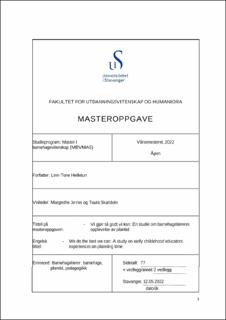| dc.description.abstract | Denne studien handler om barnehagelæreres plantid. Barnehagelærere har krav på minst fire timer plantid hver uke. Begrepet plantid dreier seg om barnehagelærernes tid satt av til utviklingsarbeid, planlegging av pedagogisk innhold samt for- og etterarbeid. Jeg ville finne ut av i hvor stor grad barnehagelærere får de fire timene plantid de har krav på, og om disse fire timene er nok for å fullføre alle arbeidsoppgaver. Jeg ville også se på om de tar ut ekstra plantid når de egentlig skal være på avdelingen, og om de jobber i fritiden sin. Videre ville jeg se på hva barnehagelærerne jobber med i plantiden, hva de ønsker å jobbe mer med, og hva de ønsker å jobbe mindre med. Fordi undersøkelsen ble gjort mens barnehagene var påvirket av koronapandemien ville jeg også tilegne meg kunnskap om hvordan, og i hvor stor grad denne påvirket barnehagelærernes plantid.
Gjennom en mixed methods studie har jeg studert barnehagelæreres opplevelse av egen plantid. Dette har jeg gjort ved hjelp av spørreskjema med en blanding av åpne spørsmål, og spørsmål med lukkede svaralternativer. Spørreskjemaet ble sendt til samtlige barnehager i en kommune på Sør-Vestlandet. 95 barnehagelærere valgte å svare på spørreskjemaet.
Hovedfunn fra studien er at barnehagelærerne i middels eller mindre grad blir ferdige med alle oppgavene de skal gjøre i plantiden. Relativt få av informantene bruker tiden de egentlig skulle vært på avdelingen for å gjøre planleggingsarbeid, mens mange bruker fritiden sin på slikt arbeid. Noe over halvparten av informantene har normalt mulighet til å ta ut fire timer plantid hver uke, resten har varierte muligheter for dette. Det de jobber mest med i plantiden er foreldresamtaler, dokumentasjon, arbeid knyttet til enkeltbarn og å lage planer. Mange av informantene bruker plantid på arbeid med pedagogisk innhold for sin avdeling. De oppgir likevel at de ikke får nok tid til arbeid med pedagogikk og at pedagogisk innhold ofte må tas på sparket. Det er også pedagogikk de setter høyest som ønske, av arbeidsområder de vil jobbe mer med. På den andre siden viser resultatene at barnehagelærerne vil bruke mindre tid på administrative oppgaver i sin plantid. Koronapandemien har påvirket mange av informantenes muligheter for å ta ut plantid. Dette begrunner de med at det var vanskelig å ta ut plantid da barnehagen var på rødt nivå, sykdom blant personalet og at det ikke var mulig å hjelpe hverandre på tvers av avdelinger. Rødt nivå vil si at barna måtte deles inn i små kohorter med en eller få voksne i hver kohort. Kohortene skulle holdes adskilt, og kunne derfor ikke samarbeide. | |
| dc.description.abstract | This is a study regarding early childhood educators planning time. Early childhood educators maintain a claim of at least four hours of planning, every week. The term planning, means the early childhood educators time for work related to developing, planning of pedagogical content and pre- and post, work-related plans. My goal was to find as to which degree an early childhood educator gets their promised four hours of planning, as is their right, and if these four hours is sufficient to complete all the tasks given to an early childhood educator. I also wanted to investigate if the early childhood educators were planning more than these four hours, and if the early childhood educators sometimes brought their work home with them. Furthermore, I wanted to study the content that the early childhood educators were spending their planning on, what they themselves wanted to work with, and what they wanted to work less with. Since this study was conducted while the kindergartens were affected by the corona-pandemic I decided to acquire knowledge regarding how and at what degree the pandemic had affected the early childhood educators time for planning.
I have studied the early childhood educators experience of their own planning time, by using a mixed methods study. It was done by using questionnaires and a mix of open and closed set of questions. These questionnaires were sent to every kindergarten in a municipality on the south-west of Norway. A total of 95 early childhood educators chose to answer the questionnaire.
The main findings from my study were that the early childhood educators were able to complete all their given tasks during their planning time, to a low or medium extent. Just a handful of the informants in this study, spent time planning, when they originally should have been working in their unit. Most of the informants spent their off time to complete tasks given to them. A little over half of the informants could normally use their four hours of planning time during a week, the rest of the informants had other variations. The planning time of the informants were mostly spent on planning for parent conversations, documentation, work with pedagogy customized to a single child and making of plans regarding the unit and kindergarten. Most of the informants spent their planning time planning for pedagogical content for their own unit. Nevertheless, the informants register that the time is not sufficient to work in-depth with pedagogical issues, and most of the time pedagogical arenas must be met with improvisation. In all the areas registered by my questionnaire, pedagogy is by far the most sought-after area to work with during planning, registered by the informants. On the other hand, the informants also register their least favorite area, and would like to spend less time on administrative assignments during their planning. Th corona pandemic has affected a lot of the informants’ possibilities with finding the time for their four hours of planning time. The reason for this, is given by the informants to be the kindergartens red-level restriction policy, not being able to get help from other units, and general sickness in the workforce given by the corona pandemic in general. The red-level restriction is explained as each unit having to break into smaller cohorts, with fewer adults in each cohort than a normal unit. These cohorts were supposed to stay separated, and thus could not cooperate. | |
